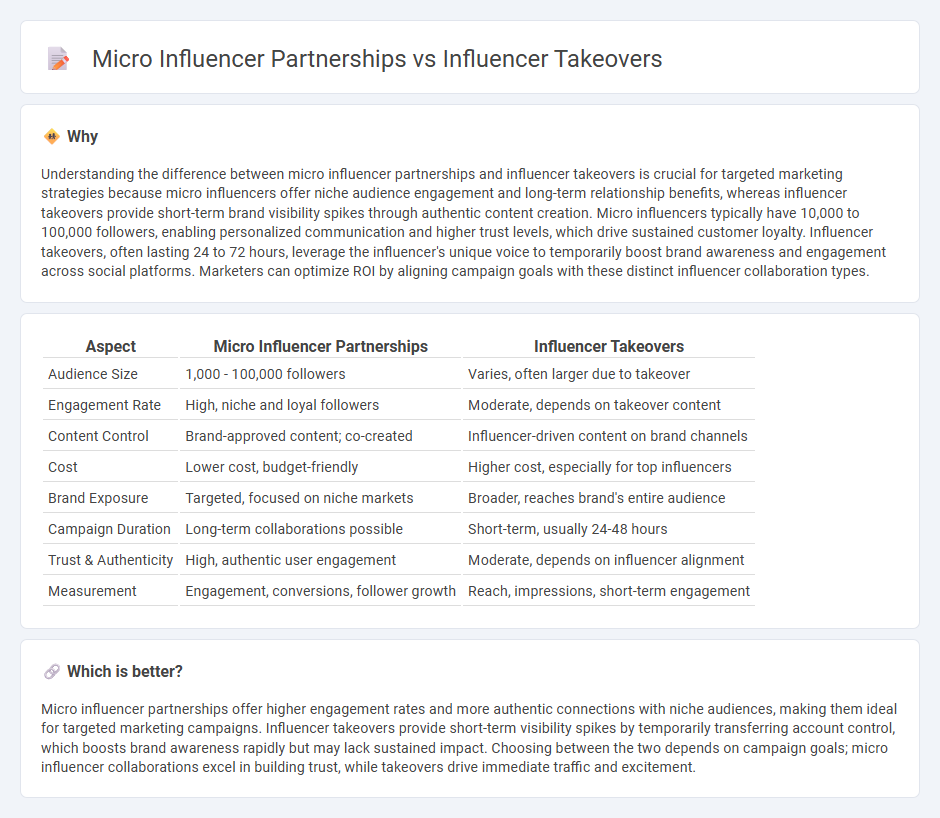
Micro-influencer partnerships generate authentic engagement through niche audiences, often resulting in higher conversion rates compared to broad influencer takeovers, which temporarily capture widespread attention but may lack deep consumer trust. These targeted collaborations leverage relatability and trust to build brand loyalty, while influencer takeovers focus on brand visibility across larger demographics. Explore strategic differences and benefits to optimize your marketing campaigns effectively.
Why it is important
Understanding the difference between micro influencer partnerships and influencer takeovers is crucial for targeted marketing strategies because micro influencers offer niche audience engagement and long-term relationship benefits, whereas influencer takeovers provide short-term brand visibility spikes through authentic content creation. Micro influencers typically have 10,000 to 100,000 followers, enabling personalized communication and higher trust levels, which drive sustained customer loyalty. Influencer takeovers, often lasting 24 to 72 hours, leverage the influencer's unique voice to temporarily boost brand awareness and engagement across social platforms. Marketers can optimize ROI by aligning campaign goals with these distinct influencer collaboration types.
Comparison Table
| Aspect | Micro Influencer Partnerships | Influencer Takeovers |
|---|---|---|
| Audience Size | 1,000 - 100,000 followers | Varies, often larger due to takeover |
| Engagement Rate | High, niche and loyal followers | Moderate, depends on takeover content |
| Content Control | Brand-approved content; co-created | Influencer-driven content on brand channels |
| Cost | Lower cost, budget-friendly | Higher cost, especially for top influencers |
| Brand Exposure | Targeted, focused on niche markets | Broader, reaches brand's entire audience |
| Campaign Duration | Long-term collaborations possible | Short-term, usually 24-48 hours |
| Trust & Authenticity | High, authentic user engagement | Moderate, depends on influencer alignment |
| Measurement | Engagement, conversions, follower growth | Reach, impressions, short-term engagement |
Which is better?
Micro influencer partnerships offer higher engagement rates and more authentic connections with niche audiences, making them ideal for targeted marketing campaigns. Influencer takeovers provide short-term visibility spikes by temporarily transferring account control, which boosts brand awareness rapidly but may lack sustained impact. Choosing between the two depends on campaign goals; micro influencer collaborations excel in building trust, while takeovers drive immediate traffic and excitement.
Connection
Micro influencer partnerships leverage relatable personalities with niche audiences to boost authentic brand engagement, while influencer takeovers amplify this effect by allowing these influencers to directly control a brand's social media channels temporarily. Both strategies maximize targeted reach and trust, driving higher conversion rates compared to traditional advertising. Combining micro influencers' credibility with takeover visibility creates powerful synergy in modern marketing campaigns.
Key Terms
Audience Reach
Influencer takeovers typically offer a broad audience reach by leveraging the host account's existing followers alongside the influencer's fanbase, resulting in heightened brand visibility and engagement. Micro influencer partnerships target niche, highly engaged communities, often yielding more authentic interactions and higher conversion rates despite smaller overall reach. Explore how balancing these strategies can optimize your marketing impact and deepen audience connections.
Engagement Rate
Influencer takeovers often generate high engagement rates by leveraging the influencer's authentic voice directly on the brand's platform, creating immediate and interactive content that resonates with followers. Micro influencer partnerships foster steady engagement through consistent, niche-targeted content that builds trust and deeper connections over time, typically resulting in higher engagement rates per follower than macro influencers. Explore in-depth strategies to optimize engagement rates through both influencer takeovers and micro influencer collaborations.
Brand Authenticity
Influencer takeovers typically offer real-time brand engagement by allowing influencers to control social media channels, fostering direct audience interaction and authentic content flow. Micro influencer partnerships emphasize long-term collaborations with niche audiences, boosting trust through consistent, relatable endorsements that resonate deeply with targeted communities. Explore how these strategies can enhance your brand authenticity and connect with your ideal customers.
Source and External Links
Takeovers: Examples And A How-To Guide - This guide explains how social media takeovers work, highlighting benefits such as new storytelling angles and increased brand awareness.
Influencers & Instagram Takeovers - This article discusses how Instagram takeovers involve influencers creating content on behalf of brands, often for events or product launches.
Social media takeovers: How to keep brand content fresh - It outlines strategies for finding the right influencer and crafting a collaborative content plan to maintain brand freshness.
 dowidth.com
dowidth.com